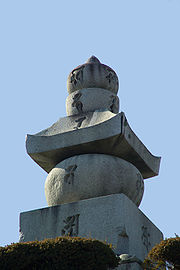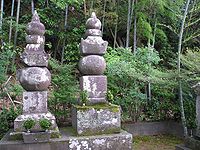
Gorinto
Encyclopedia

Tō
The , sometimes also called or is the Japanese version of the Chinese pagoda, itself an interpretation of the Indian stupa. Pagodas are quintessentially Buddhist and an important component of Japanese Buddhist temple compounds but, because until the Kami and Buddhas Separation Act of 1868 a...
believed to have been first adopted by the Shingon and Tendai
Tendai
is a Japanese school of Mahayana Buddhism, a descendant of the Chinese Tiantai or Lotus Sutra school.Chappell frames the relevance of Tendai for a universal Buddhism:- History :...
sects during the mid Heian period
Heian period
The is the last division of classical Japanese history, running from 794 to 1185. The period is named after the capital city of Heian-kyō, or modern Kyōto. It is the period in Japanese history when Buddhism, Taoism and other Chinese influences were at their height...
. It is used for memorial or funerary purposes and is therefore common in Buddhist temples and cemeteries. It is also called ("five-ringed stupa") or , where the term sotoba is a transliteration of the Sanskrit word stupa
Stupa
A stupa is a mound-like structure containing Buddhist relics, typically the remains of Buddha, used by Buddhists as a place of worship....
. The stupa was originally a structure or other sacred building containing a relic of Buddha or of a saint, then it was gradually stylized in various ways and its shape can change quite a bit according to the era and to the country where it is found. Often offertory strips of wood with five subdivisions and covered with elaborate inscriptions also called sotoba can be found at tombs in Japanese cemeteries (see photo below). The inscriptions contain sūtra
Sutra
Sūtra is an aphorism or a collection of such aphorisms in the form of a manual. Literally it means a thread or line that holds things together and is derived from the verbal root siv-, meaning to sew , as does the medical term...
and the posthumous name of the dead person. These can be considered stupa variants.
Structure and meaning

Mahabhuta
Mahābhūta is Sanskrit and Pāli for "great element." In Buddhism, the "four great elements" are earth, water, fire and air...
in Sanskrit
Sanskrit
Sanskrit , is a historical Indo-Aryan language and the primary liturgical language of Hinduism, Jainism and Buddhism.Buddhism: besides Pali, see Buddhist Hybrid Sanskrit Today, it is listed as one of the 22 scheduled languages of India and is an official language of the state of Uttarakhand...
, or Godai in Japanese): the earth ring (cube), the water ring (sphere), the fire ring (pyramid), the air ring (crescent), and the ether ring, (or energy, or void). The last two rings (air and ether) are visually and conceptually united into a single subgroup. The last shape, ether, is the one that changes most according to the country, and in Japan it's close to that of a lotus flower. The rings express the idea that after death our physical bodies will go back to their original, elemental form. Gorintō are usually made of stone, but some built in wood, metal, or crystal exist.

Nichiren
Nichiren was a Buddhist monk who lived during the Kamakura period in Japan. Nichiren taught devotion to the Lotus Sutra, entitled Myōhō-Renge-Kyō in Japanese, as the exclusive means to attain enlightenment and the chanting of Nam-Myōhō-Renge-Kyō as the essential practice of the teaching...
and Tendai
Tendai
is a Japanese school of Mahayana Buddhism, a descendant of the Chinese Tiantai or Lotus Sutra school.Chappell frames the relevance of Tendai for a universal Buddhism:- History :...
temples sometimes a gorintō will have carved on it the (see photo).
The gorintō as a symbol belongs to literally "secret teachings", term often translated as "esoteric Buddhism"), a Japanese
Japanese language
is a language spoken by over 130 million people in Japan and in Japanese emigrant communities. It is a member of the Japonic language family, which has a number of proposed relationships with other languages, none of which has gained wide acceptance among historical linguists .Japanese is an...
term that refers to the esoteric
Esotericism
Esotericism or Esoterism signifies the holding of esoteric opinions or beliefs, that is, ideas preserved or understood by a small group or those specially initiated, or of rare or unusual interest. The term derives from the Greek , a compound of : "within", thus "pertaining to the more inward",...
Vajrayāna
Vajrayana
Vajrayāna Buddhism is also known as Tantric Buddhism, Tantrayāna, Mantrayāna, Secret Mantra, Esoteric Buddhism and the Diamond Vehicle...
practices of the Shingon
Shingon Buddhism
is one of the mainstream major schools of Japanese Buddhism and one of the few surviving Esoteric Buddhist lineages that started in the 3rd to 4th century CE that originally spread from India to China through traveling monks such as Vajrabodhi and Amoghavajra...
Buddhist
Buddhism
Buddhism is a religion and philosophy encompassing a variety of traditions, beliefs and practices, largely based on teachings attributed to Siddhartha Gautama, commonly known as the Buddha . The Buddha lived and taught in the northeastern Indian subcontinent some time between the 6th and 4th...
school and the related practices that make up part of the Tendai
Tendai
is a Japanese school of Mahayana Buddhism, a descendant of the Chinese Tiantai or Lotus Sutra school.Chappell frames the relevance of Tendai for a universal Buddhism:- History :...
school. In those esoteric disciplines, the first two shapes (the cube and the sphere) represent the most perfect doctrine, and are supposed to contain in themselves the other three. Together they represent the (lit. "real world"), that is the realm of perfect understanding, whereas the others constitute the (lit. "world of mutation"),or the world of impermanence, which includes the , the world we live in.
On a second level of symbolism, each part of the gorintō also represents an element of change in both Jutsuzaikai and Henkai.
- The top symbol fuses the shape of a crescent, representing wisdom, and a triangle, representing principle. The fusion of these qualities in the Genshōkai and Henkai represents perfection, or Buddhahood.
- The crescent of water represents receptivity, and is similar to a cup ready to receive from the heavens.
- The triangle is a point of transition between two worlds and as such represents both unification and movement. It indicates the activity necessary to reach Enlightenment.
- The circle represents completion, or Wisdom attainment.
- The square is a symbol of the four elements.

- The square is the basis, the will to attain perfection.
- The circle is the attainment of equanimity.
- The triangle represents the energy created in pursuit of the truth.
- The crescent represents the development of intuition and awareness.
- The topmost shape represents perfection.
History of the gorintō in Japan
The theory of five elements was born in India, but the development of the Japanese gorintō shows the deep influence of Mikkyō, and in particular of KūkaiKukai
Kūkai , also known posthumously as , 774–835, was a Japanese monk, civil servant, scholar, poet, and artist, founder of the Shingon or "True Word" school of Buddhism. Shingon followers usually refer to him by the honorific titles of and ....
and Kakuban
Kakuban
Kakuban , known posthumously as Kōgyō-Daishi was a priest of the Shingon sect of Buddhism in Japan and credited as a reformer, though his efforts also led to a schism between and...
. The use of gorintō is thought to have begun in the second half of the Heian period
Heian period
The is the last division of classical Japanese history, running from 794 to 1185. The period is named after the capital city of Heian-kyō, or modern Kyōto. It is the period in Japanese history when Buddhism, Taoism and other Chinese influences were at their height...
. The oldest known examples can be found at Chūsonji, Iwate Prefecture
Iwate Prefecture
is the second largest prefecture of Japan after Hokkaido. It is located in the Tōhoku region of Honshū island and contains the island's easternmost point. The capital is Morioka. Iwate has the lowest population density of any prefecture outside Hokkaido...
, are a mix of gorintō and hōtō
Tahōtō
A is a form of Japanese pagoda found primarily at Esoteric Shingon and Tendai school Buddhist temples. It is unique among pagodas because it has an even number of stories...
(two-storied Buddhist tower) and go back to 1169. They then came into normal use during the Kamakura period
Kamakura period
The is a period of Japanese history that marks the governance by the Kamakura Shogunate, officially established in 1192 in Kamakura by the first shogun Minamoto no Yoritomo....
and are still widely used today for memorial monuments and tombs, particularly but not exclusively in Buddhist temples. A gorintō is for example the traditional headstone shape of a Shingon sect grave.

